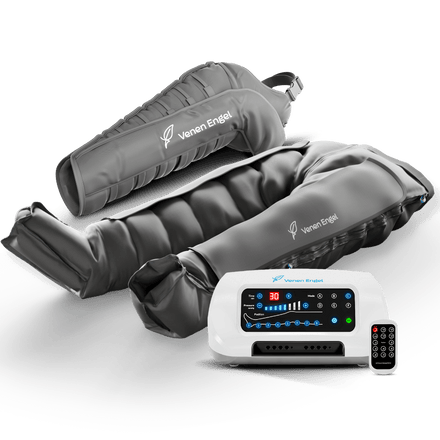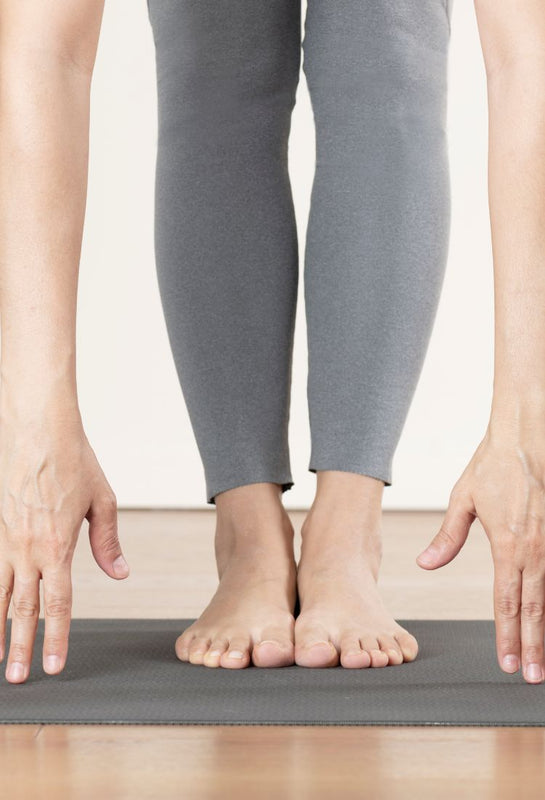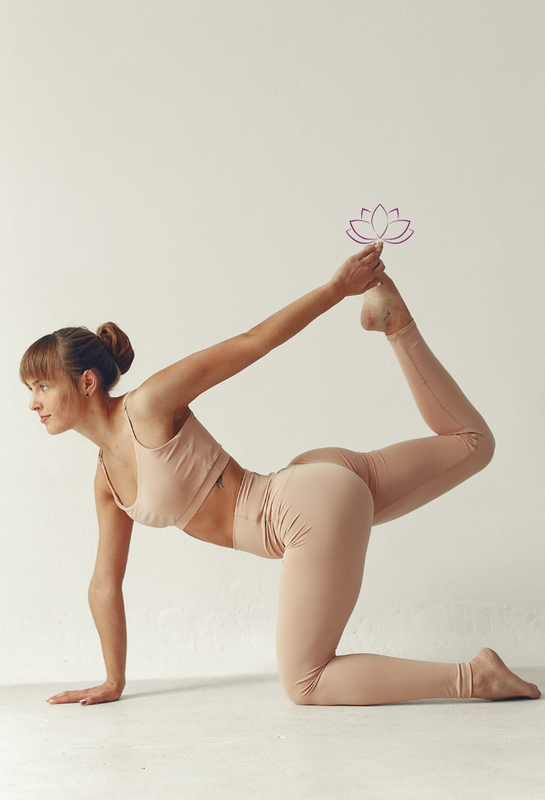
Yoga not only helps you strengthen your muscles and increase your flexibility. If you are affected by lipedema or lymphedema, yoga can be a wonderful addition to your daily self-care routine. The gentle practice promotes lymph flow, improves overall well-being—both physically and mentally—and helps reduce swelling. Through conscious movements and breathing techniques, venous and lymphatic circulation is stimulated and the body is gently detoxified. In this article, we take a closer look at how yoga exercises can bring relief to your daily life with lymphedema symptoms.
Good to know
The effect of yoga on your lymphatic system
Yoga combines movement and conscious breathing in harmonious sequences of asanas, which are performed dynamically or statically depending on the style. This practice affects not only the muscles but also the lymphatic system—an essential part of your immune system. The lymphatic system transports lymph fluid throughout the body and ensures that waste products are removed. Unlike the circulatory system, it does not have its own pump and relies on muscle movements and gravity to promote and maintain lymph circulation. Yoga naturally supports this process. By moving your body through gentle stretches and compressions, various body areas are gently "wrung out" like a sponge and flushed with fresh fluid. The combination of conscious breathing and targeted movements not only promotes venous and lymphatic return but also effectively strengthens your immune system.

Why the Lymphatic System is Crucial for Your Well-being The lymphatic system is an often underestimated part of our body. It consists of a network of lymph vessels, nodes, and organs that work together to regulate fluid in the tissue, remove toxins, and support the immune system. When this system is overloaded, as is often the case with lipedema or lymphedema, it leads to congestion, which can cause swelling and pain. Particularly problematic is that lymph circulation depends on movement – and this is exactly where yoga can be crucially helpful.
How Yoga Activates Lymph Flow Yoga offers a variety of mechanisms to support lymph circulation. Through targeted stretches and movements that create compression and relaxation, lymph flow is stimulated, similar to a gentle massage. In particular, the breathing techniques, which are often a central component of yoga, help promote fluid transport in the abdomen and chest. This combination of movement and breathing technique makes yoga a holistic approach to promoting the lymphatic system.
the best exercises
Yoga exercises to support the lymphatic system

Ardha Matsyendrasana
Twisting poses like the twist seat
Examples of seated twisting poses include the twist seat (Ardha Matsyendrasana) and the simple side twists while sitting, which you can adjust individually to your flexibility. These positions relieve the lower back and promote the circulation of the abdominal organs, which is particularly helpful in the removal of metabolic waste products in the abdominal area.
Paschimottanasana
Forward Bend
Add your own custom content to provide more information about your store, availability details...

Standing Postures
Activation by Movement
Standing yoga poses also play a central role in the lymph flow as they promote the entire lymphatic system. Asanas such as the high lunge (Alanasana), the tree pose (Vrksasana), or the warrior poses (Virabhadrasana I, II, and III) support the natural return flow of the lymph from the extremities to the central lymph nodes and finally back into the bloodstream through targeted muscle work. Activating the muscles in the torso, legs, and arms not only strengthens the lymphatic circulation, allowing excess fluid to be drained more efficiently from the tissue, but also improves the venous return.
Virabhadrasana II
Krieger II
Stand in a wide stance and bend the front knee while keeping the back leg straight. This posture activates the muscles in the legs, which in turn promotes lymph flow in the lower extremities.


Trikonasana
Triangle position
Starting from Warrior II pose, extend the front arm towards the floor and the other arm towards the ceiling. This pose opens the sides and stimulates the lymphatic pathways in the chest and armpit area.
Moreover, standing positions significantly contribute to promoting a healthy posture by straightening the spine and opening the chest – an important aspect for the free lymph flow, especially in the areas of the groin and armpits, where many central lymph nodes are located. The conscious opening of these regions stimulates the lymph nodes, supports fluid drainage, and strengthens the body's natural detoxification. At the same time, an upright posture helps to harmonize the lymph flow and counteract swelling in the legs and feet.
Backbends – Opening and Oxygenation.
Backbends are particularly effective for opening the chest and improving oxygen supply. Backbends enhance circulation throughout the body, thereby promoting the removal of lymph fluid and preventing congestion. By actively strengthening the back, gluteal, and abdominal muscles, the lymph remains in motion. Stretching the chest muscles opens the chest, facilitates deeper breaths, and additionally stimulates the lymph flow.
Typical backbends like the Cobra (Bhujangasana) or the Shoulder Bridge (Setu Bandhasana) strengthen the upper back and relieve the spine. They promote oxygen supply and refresh the entire body system, which is essential for vitality and for promoting a balanced lymph flow.
Cobra Pose
Cobra
Lie on your stomach and gently push your upper body upwards. This posture opens the chest and stimulates the lymph nodes in the armpits. At the same time, it promotes deep breathing.


Setu Bandhasana
Shoulder Bridge
Lie on your back, place your feet close to your buttocks, and lift your hips. This position relieves the lower back and promotes circulation in the abdomen and chest.
Inversions
Use gravity to your advantage
Inversions are ideal for directing fluid from the legs back into the upper body.
Viparita Karani
Waterfall
Lie on your back and stretch your legs up against the wall. This position is particularly helpful for reducing swelling in the legs.


Downward-Facing Dog Pose
Dog with head down
This posture activates the entire body and promotes circulation. Make sure not to overstrain the position, especially if you are a beginner.
Pranayama
Breathing exercises to support the lymphatic system
In addition to the asanas, deep, conscious breathing plays an important role in supporting lymph flow and resolving congestion. During inhalation, the diaphragm rises and exerts pressure on the internal organs, promoting the movement of lymph fluid in the abdominal cavity. During exhalation, the diaphragm lowers, and the organs return to their original position, stimulating lymph flow. Breathing exercises such as deep abdominal breathing are powerful tools to promote lymph flow, reduce stress, and regulate your nervous system. Through conscious breathing techniques, you support both the detoxification of your body and your overall well-being.
Deep Abdominal Breathing: You can apply this simple technique anywhere. Sit comfortably, place one hand on your abdomen, and feel it rise and fall with each breath. This movement activates the lymph flow in the abdominal area.
Alternate Nostril Breathing (Nadi Shodhana): This technique not only calms the mind but also promotes the flow of energy in the body. It is particularly effective for starting or ending the day with tranquility.
Your new lifestyle
Yoga as Part of a Holistic Lifestyle
In addition to yoga practice, other factors also play a role in supporting the lymphatic system. A conscious diet, adequate fluid intake, and regular exercise can enhance the positive effects of yoga.
Nutrition and Yoga – A Perfect Combination An anti-inflammatory diet can help reduce water retention. Foods like ginger, turmeric, citrus fruits, and green leafy vegetables promote circulation and help the body eliminate toxins.
Practical tips for integrating yoga into daily life: It doesn't always have to be a long yoga session. Even five minutes of deep abdominal breathing or a short inversion pose like the waterfall can help reduce swelling and relax the body.
Meditation and Mindfulness: Meditation and mindfulness exercises are also valuable additions to yoga practice. Stress and inner tension can worsen water retention and lymphatic congestion, so regular mindfulness practice helps promote mental calm and serenity. A calming meditation can relax the nervous system and indirectly contribute to improving lymphatic flow. Tips for Practice: Flowing Breath: Pay attention to deep and even breathing during the exercises. Mindfulness: To specifically activate lymph flow in your yoga poses, it is important to perform the movements slowly and consciously. Be mindful during the exercises and listen to your body. If you feel pain, adjust the pose or switch to another one. Regularity: Perform these exercises regularly to achieve the best results for lymph flow.
Conclusion
Why is yoga beneficial for water retention?
Yoga is a gentle yet effective support for the body and mind to stimulate the lymph flow and relieve the body. Through regular yoga practice, you can not only alleviate physical complaints such as swelling and lymphatic congestion, but also strengthen your body awareness and find mental relaxation. It is important to practice mindfully and respect your own limits. Every body is different, and it requires patience and care to enhance your well-being in the long term.
Yoga helps with water retention by:
- Improves lymph circulation: Targeted exercises promote the removal of excess fluid from the tissue.
- Stimulates blood circulation: Gentle movements support blood flow and thus help reduce swelling.
- Increases flexibility and strength: Yoga strengthens the muscles and improves flexibility, which can reduce discomfort from water retention.
- Reduces stress: The calming effect of yoga reduces stress, which can worsen water retention.
Find the yoga style that suits you best:
Certain yoga styles are particularly suitable for gently stimulating your lymph circulation, reducing swelling, and connecting with your body.
Yin Yoga: Yin Yoga is a calm and meditative yoga style where the asanas are held passively for an extended period (about 2 to 5 minutes). The gentle pressure of one's own body weight is deliberately used to target the deeper connective tissue, fascia, and joints. By statically remaining in the positions, the elasticity of the tissue is improved, adhesions are released, and the flow of fluid in the lymphatic vessels is stimulated. This can be particularly beneficial for lymphedema, as it reduces tension in the tissue and gently supports circulation.
Yin Yoga also offers you a space for relaxation and mindfulness, allowing not only the body but also the mind to regenerate – a holistic approach that strengthens self-care and promotes well-being.
Hatha Yoga: Hatha Yoga is a calm yet strengthening practice that supports the lymphatic system through gentle, mindful movements and breathing techniques. Through slow, controlled movements and a focus on breath and body awareness, Hatha Yoga gently supports circulation and can thus reduce congestion that often occurs with water retention in the body.
The asanas are performed at a slow pace and held for a few breaths, creating a strong connection between body and mind in Hatha and promoting physical and mental balance.
Vinyasa Yoga (adapted): Vinyasa Yoga is usually a more dynamic style, but an adapted, gentle version can also be helpful in promoting lymph circulation through flowing movements and light sweating. A gentle Vinyasa class can help you stay active and stimulate circulation without putting too much strain on the tissues.
It is important to avoid overly demanding sequences that could cause you to overheat or hinder lymphatic flow. Simple variations of asanas with breaks and time for regeneration are often more effective here than overly demanding or advanced positions.
Try it out and feel the difference
Discover how positively yoga practice can affect your well-being and lymph flow. Just a few minutes a day, consciously connected with your breath and body, can make a difference: reduce swelling, relieve tension, and provide a feeling of lightness and relief. Take the time to practice mindfully and give your body the support it deserves – for a healthy, relaxed, and vital everyday life!
About the Author: Barbara is our Brand Manager at Venen Engel and additionally a certified yoga instructor. In her Hatha-inspired classes, she guides participants on their journey to physical and mental balance as well as holistic well-being. With a lot of mindfulness, she encourages her students to strengthen their own body awareness and to perceive themselves better.








